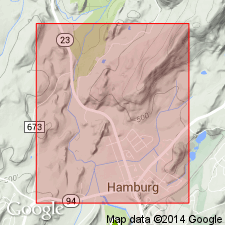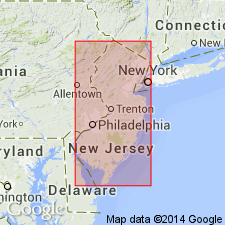
- Usage in publication:
-
- Beaver Run Member
- Modifications:
-
- Named
- Dominant lithology:
-
- Dolomite
- Chert
- AAPG geologic province:
-
- New England province
Summary:
Massive, fossiliferous, black dolomite with chert beds here named Beaver Run Member of Ontelaunee Formation, probably for tributary of Wallkill River, or for village of Beaver Run, both West of Hamburg, Sussex Co., NJ. Dolomite is sparkly; emits fetid odor when struck. 150-200 ft (45-61 m) thick. Overlies Lafayette Member of Epler Formation; underlies Harmonyvale Member of Ontelaunee Formation. Includes three unnamed members. Age is Early Ordovician.
Source: GNU records (USGS DDS-6; Reston GNULEX).

- Usage in publication:
-
- Beaver Run Member
- Modifications:
-
- Overview
- AAPG geologic province:
-
- Appalachian basin
Summary:
Nomenclature in this report follows Markewicz and Dalton (1977) who divided the Ontelaunee Formation in NJ into the Beaver Run Member and the Harmonyvale Member. The Beaver Run is 150 to 200 ft thick and contains three distinct units: 1) lower massive, medium-to coarsely crystalline, black, sparkly, fetid dolomite; 2) massive dolomite similar to the lower part but with a large amount of bedded, anastomosing, rugose, and knotted chert; and 3) upper massive, fine- to medium-grained, black sparkly, fetid dolomite, generally with little chert. The base of the Ontelaunee as defined by Markewicz and Dalton (1977) does not coincide exactly with that of Hobson (1963). Hobson may have included a part of the Lafayette Member in the Ontelaunee. Base here considered to be at the change from the fine-grained laminated dolomite of the Lafayette to the coarser-grained dolomite of the Beaver Run. Age of the Ontelaunee shown as entirely within the Early Ordovician.
Source: GNU records (USGS DDS-6; Reston GNULEX).
For more information, please contact Nancy Stamm, Geologic Names Committee Secretary.
Asterisk (*) indicates published by U.S. Geological Survey authors.
"No current usage" (†) implies that a name has been abandoned or has fallen into disuse. Former usage and, if known, replacement name given in parentheses ( ).
Slash (/) indicates name conflicts with nomenclatural guidelines (CSN, 1933; ACSN, 1961, 1970; NACSN, 1983, 2005, 2021). May be explained within brackets ([ ]).

